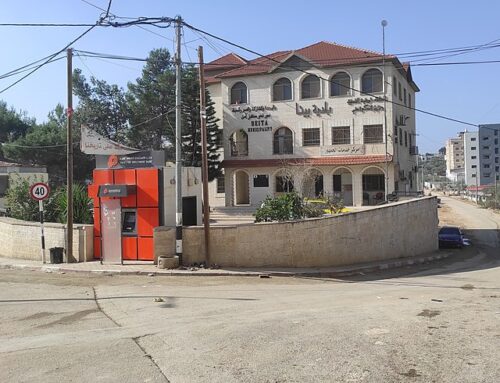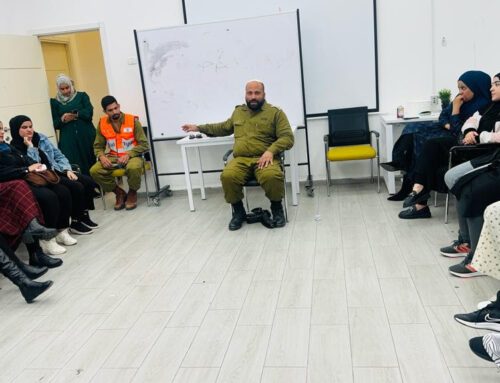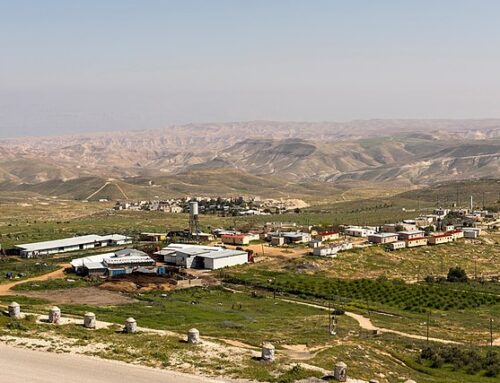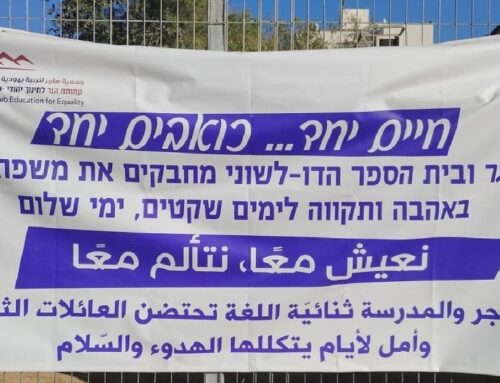The following is the final installment of Merle Wolofsky’s report (click here for Part 2) on her experience as a participant in PPI’s recent Israel Symposium:
 |
| Meeting in Rawabi with Bashar Masri, the development’s managing director. |
Rawabi is a city being built outside of Ramallah that will eventually house 40,000 people. We were very impressed with the young woman who guided us (an engineer) and the beauty and scope of the endeavor. Rawabi’s developers sought advice from the world-famous Israeli architect, Moshe Safdie, whose influence is evident. The plans include a mosque, a church, a shopping mall, schools, theatre, sports coliseum and a collaborative industrial park for Israelis and Palestinians. It was clear that there are highly educated and skilled people living in the West Bank, including engineers, investors, architects, city planners, and craftsmen. One-third of the thousands employed in this project are women.
The caveat that I had mentioned refers to what we heard from Amira Hass, a Jewish-Israeli journalist based in Ramallah who dismissed the Palestinians we heard from as untrustworthy and part of the corrupt, inept leadership. However she was even more vituperative in her judgment of Israel’s leadership and actions.
The Israeli-Arab Director of the Naqab Office of Adalah–The Legal Center for Arab Minority Rights in Israel, Dr. Thabet Abu Rass, explained that the Negev comprises 60% of the land of Israel and contains 8% of its population. Ninety-five percent of the Negev is state land and five percent is disputed, in which the Bedouin have “usage.” The pending Prawer-Begin Bill will reduce this amount to less than 1% of the Negev, and could result in forcibly moving up to 40,000 people. The given reasoning for this is to develop the Negev.
Viewing unrecognized Bedouin villages He then took us to two unrecognized villages and one recently recognized by the State, and what we saw was most disturbing. If a village is not recognized, it cannot be hooked up to the electrical grid whose high tension wires are strung above it. It cannot get water lines from the pipes that are at its edges. It will not have a medical clinic and the roads are so bad that it would be impossible to bring ambulances in case of emergency.
The High Court of Israel ruled that the government had to build a school, which they did, but that too was not connected to water or electricity. And a final insult was that government plans to include a toxic waste plant in that area. The man who spoke to us begged us to be their voice to stop the demolitions and transfers and bring them the services they need.
This morning left me in despair that conditions like these people face are in Israel. Our guide then explained that there is often conflict between tribal and state law with understanding of who ‘owns’ what land and the people will not cross tribal law. He felt that the authorities must meet with the tribal elders to try to find compromises. He finished by describing an experience he had witnessing human trafficking at the border. When I got back I looked online and learned that Truah: the Rabbinic Call for Human Rights, the Religious Action Center of Reform Judaism and the Reconstructionist Rabbinical Association have all voiced their concern to the Knesset.
It was encouraging to meet with Khadra El Saneh, Director of Sidreh, a non-profit organization that empowers, represents and improves the socio-economic conditions of Bedouin Women in Israel’s Negev Desert.
Another community of Israeli Arabs we meet were in the Galilee.
We had lunch with Riad Kaba, the Director of the Jewish-Arab Center for Peace, in an Israeli-Arab town [Kafr Qara] where education for both men and women is the norm. He clearly said that his community has become Israeli in culture and that this country was the home they wanted for themselves. The owner of the restaurant was a woman, the mother of two university students, who had built a successful enterprise.
We toured Barta’a and East Barta’a. This is actually one town cut in half by the Green Line border back in 1948-’49. Now it has been totally included on the Israeli side of the separation wall, even though legally part of the village is Israeli and part is in the West Bank.
One of the interesting things we learned was that when the ceasefire was achieved in 1949, Israel was cut in two by a series of Arab villages in the area. Golda Meir’s visit to the King of Jordan resulted in a land swap giving Israel continuous land in the Galilee for Jordan to get access to the Dead Sea.
My conclusion: The situation of the Bedouin is totally untenable and it is not overstating it to say that Israel policy in the region is immoral. It would not surprise me at all if this community turned to desperate measures to get basic justice. The rest of the Palestinian and Israeli Arabs we met were not belligerent or aggressive. They seem to recognize the positive aspects of Israeli culture and seek to emulate the productivity and creativity that surrounds them, and realize that violence is counterproductive
I will reverse the two last speakers so as to leave you on a hopeful note. Colette Avital said that many Israelis live in a bubble at home and in the surrounding area. She worries that we may turn from our traditional Western orientation towards the far east where business supersedes human rights concerns and that our government’s tenacity to our demands vis-a-vis the Palestinians will doom the talks.
On a much more optimistic note, we met with Ilan Baruch, a former ambassador to Namibia and South Africa, who is now the foreign affairs adviser for the head of Meretz, Zehava Galon. He pointed out that former enemies now get along. He finds hope and inspiration from the example of post-WW 2 Europe, functioning in peace with Israel looking to Germany as an ally, and that South Africa has managed to find reconciliation. He also sees great leadership capabilities in Zehava Galon, if she could somehow take over from Bibi.







Leave A Comment